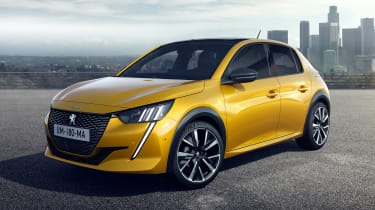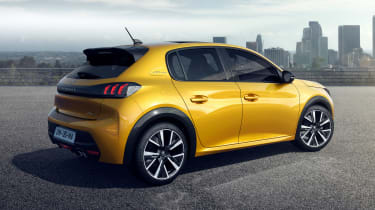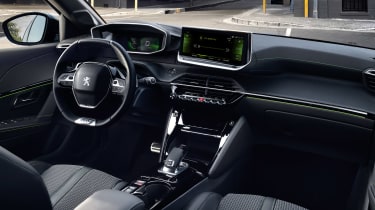New 2019 Peugeot 208 now available to order
The new Peugeot 208 is here, ready to challenge the Ford Fiesta's reign with a new platform, engines and tech, plus an all-electric option
Peugeot is now taking orders for the all-new 208. The base-spec petrol variant starts from £16,250, making it more expensive than its key rival, the Renault Clio. The pure-electric Peugeot e-208 starts at £25,050 inclusive of the government’s plug-in car grant. First deliveries for both models are due in early 2020.
The 208 range comprises four trim levels (Active, Allure, GT Line and GT), with buyers being able to pick three petrol engines, one diesel or a fully electric set-up.
• New electric Peugeot e-208 revealed with 211-mile range
Standard kit across the range, starting with Active trim (£16,250) includes alloy wheels (steel wheels for the e-208), Active Safety Brake with pedestrian detection, electric and heated door mirrors and LED daytime running lights. The e-208 in Active trim also features pre-heating functionality and automatic air conditioning.
Allure models (£18,850) benefit from leather-effect seat trim, 3D i-Cockpit with a configurable 3D head-up instrument panel and ‘claw effect’ full LED rear-lights. The e-208 starts from £26,250 in Allure spec.
GT Line models (£20,070) feature front and rear parking sensors, a reversing camera, 17-inch wheels, eight-colour ambient interior lighting, and full LED headlights. Buyers will have to cough up £28,100 for the electric model in GT Line.
Only the e-208 is offered in GT spec (£29,650), which features automated parking assistance, adaptive Cruise Control with Stop & Go Alcantara trim, heated front seats, and 3D i-Cockpit with a larger 10-inch touchscreen.
New Peugeot 208: engine, tech and performance
The Mk2 208 is built on the PSA Group’s new CMP platform for B and C-segment cars, shared with the DS 3 Crossback. The same platform will feature on a glut of new models across the PSA empire, such as the next Vauxhall Corsa and Citroen C4 to name a couple. The platform itself sheds 30kg over the underpinnings of the previous generation model but, more importantly, it supports a battery electric powertrain which can be integrated on the same production line as the petrol and diesel variants of the 208 with little disruption.
Design wise, the new 208 is well-distanced from its predecessor, adopting the same design language as the new 508. The front is defined by the pair of large LED fangs hanging off the new headlights, and overall the new model receives a much sportier looking bodykit than before. GT Line cars as pictured get flared black wheel arches – a visual nod to the 205 GTI – plus a large black spoiler on the hatch-lid. Every car boasts the new, distinctive rear end too, making use of a gloss black insert spanning the width of the tailgate.
It’s a similar story in the cabin, as the 208 features a completely overhauled interior which is a far more digitalised environment than before. Some more recent Peugeot interior design elements, such as the liberal use of piano black plastics and the ‘piano key’ style switchgear, are prominent on the centre console.
The brand’s i-Cockpit dashboard layout is still used, with a fully digital instrument panel available on high-end versions of the new 208. However, the digital dashboard is a brand new development as yet unseen on any other Peugeot. The brand calls it 3D i-Cockpit, and it uses clever reflection to create the impression of three-dimensional graphics. Sitting on top of the dashboard is a floating touchscreen display. On standard 208s, it’ll measure seven-inches in size, with a ten-inch display featuring Android Auto, Apple CarPlay and built-in navigation on higher-spec cars.
Under the bonnet, Peugeot has confirmed five powertrain choices from launch. The base petrol offering is the PureTech 75. It’s a three-cylinder 1.2-litre petrol engine developing 74bhp, which sends its power to the front wheels through a five-speed manual gearbox.
The turbocharged PureTech 100 takes power up to 99bhp and adds an extra ratio to the transmission with a six-speed manual as standard. Peugeot’s EAT eight-speed automatic is optional here, with paddle shifters mounted on the back of the steering wheel. Step up another level, and the 128bhp PureTech 130 features the eight-speed automatic transmission as standard.
Diesel is a dying choice in superminis, but the new 208 launches with a single BlueHDi option. The 99bhp, 1.5-litre four-cylinder motor is linked to a six-speed manual gearbox only. No performance, fuel economy or CO2 figures have been issued, but the new car will be homologated under WLTP rules.
The biggest drivetrain news for the new 208 is the battery-electric e-208 option, which will be available from launch. The fully-electric variant of the supermini uses the e-CMP variant of the new CMP platform and is capable of 211 miles on a single charge, with the front axle powered by a 134bhp electric motor.
What does the new Peugeot 208 have to beat? These are the best superminis on the market right now...
Find a car with the experts










